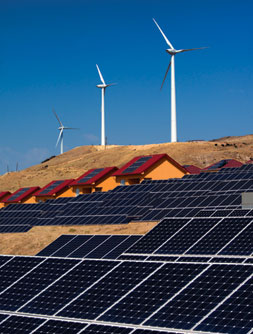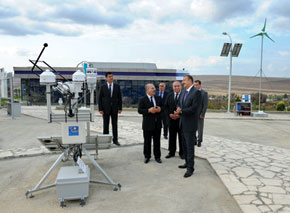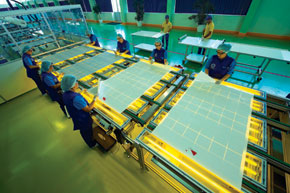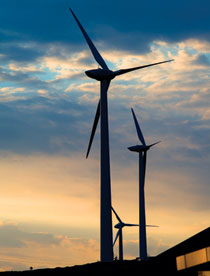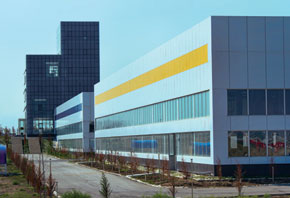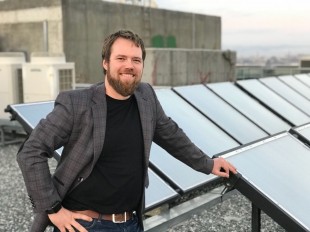Hydrocarbon producer Azerbaijan is looking to generate 20 per cent of its electricity from renewable sources by 2020. The target is set in a draft strategy drawn up by Azerbaijan’s State Agency for Alternative and Renewable Energy. According to official statistics, in 2011 9 per cent of the electricity generated in the country came from renewable sources, almost entirely hydro-electric power. Visions’ Shafiga Babayeva talks to Jamil Malikov, deputy director of the State Agency for Alternative and Renewable Energy, about their ambitious plans, the associated benefits for the oil and gas industry and the country’s false start with wind power.
The State Agency has drawn up a draft strategy for alternative and renewable energy resources until 2020. Can you tell us the main points of the strategy?
The Azerbaijan 2020: Vision of the Future development concept includes provisions on the alternative and renewable energy sector. On 29 December 2011 the head of state signed a resolution on the preparation of a State Strategy on the Use of Alternative and Renewable Energy in the Republic of Azerbaijan for the period 2012 to 2020. This strategy has already been prepared and submitted to the Cabinet of Ministers, and almost all the conclusions and proposals have been accepted. We are going to present the latest version of this strategy to the Presidential Administration in the near future.
Wind, solar, hydroelectric and biomass power have been set as the priority areas and their structural division defined. Azerbaijan’s diverse climate, with continental, mild and subtropical zones, and its varied terrain of mountains, plateaus, plains and lowlands are highly favourable for these types of power generation.
Achieving goals set by the European Union for 2020 is very important for Azerbaijan and is considered one of the main aims of the strategy. We have set a target of the generation of 20 per cent of electricity from renewable sources by 2020. The strategy includes the measures to be taken in legislation, structural and institutional development and where funds will come from to achieve these objectives. The strategy reflects the current policy and views of the state. We hope that this strategy will lead to the formation of specific projects, plans, relevant legislation and other technological and creative documents. These are the key points of our strategy.
Power generation from renewable sources is often more expensive than conventional power generation. What incentives does the strategy envisage to tackle this problem? Will there be an increase in energy tariffs or subsidies for generators?
Both tariffs and subsidies are specified in improvements to the legislative and regulatory framework for power generation from alternative and renewable energy. At the same time, the following stimuli are also planned:
• Exemption from customs duties and VAT for all equipment and spare parts used in all areas of alternative and renewable power generation imported into the country, up to and including 2020
• Tax exemptions in the field of alternative and renewable power generation up to and including 2020
• Loans and investments from the state budget in order to ensure development
• On the basis of international experience, guaranteed subsidies and grants for capital investment alongside tax and customs breaks for local enterprises producing the equipment and machinery used for alternative and renewable energy. This includes a special tariff policy for projects which use locally produced equipment.
Official statistics show that a small amount of wind power was generated in 2009 and 2010, but then stopped. Can you tell us why?
It is very simple. A private entity, the Caspian Technology Company, was producing wind energy as a pilot project. Approximately 3 million kWh of energy per year were produced by two turbines, each with a capacity of 750 kW. They were planning to construct more power plants in the future, but were not satisfied with the existing tariff and financial systems and encountered some difficulties. It was obvious that this equipment needed to be maintained on a regular basis and that funds had to be used exclusively for the operation of the equipment. The future development of the company was in doubt and it closed down. However, another private structure built a more than 8 MW power plant and we hope that this year statistics for wind power will be higher than in 2009 and 2010.
What is this private structure? Can you explain?
It’s a private body. To be honest, I don’t want to mention their names, but you will see for yourself in the statistics.
A consortium working on the pilot wind project, Nordwind Energien/Temirmashin, told the press in early 2010 that they faced three main problems with wind power in Azerbaijan: the wind was too strong or too weak; electricity tariffs were very low; and they were not able to import wind turbine blades for a reasonable price. We have already talked about tariffs. How serious are the problems connected with the “right kind of wind” and the import of turbine blades?
By decision No 161 of the Cabinet of Ministers in December 2003, wind power equipment was exempted from import duty and by decision No 220 of December 2007, imported wind power equipment was exempted from VAT. International experience shows that energy can be produced using existing technology with wind speeds of 3-25 mps (metres per second). If more expensive, advanced technology is used, energy can be generated from wind speeds of 1-60 mps. Wind energy potential in Azerbaijan is calculated at 10,000 MW. Steps will be taken to increase wind power production to 5.6% of all power generated by 2020, including 4% offshore and 1.6% onshore. Wind will then account for 28% of all power generated from alternative and renewable energy.
Does the State Agency for Alternative and Renewable Energy run any power stations or other facilities?
This is done by the Azalternativenerji limited liability company which is subordinate to the State Agency. The Qobustan Experimental Site is run by Azalternativenerji. The site, which covers 38 hectares, has wind, solar and biogas stations.
Another facility is the Azguntex factory near Sumqayit, which has two production lines – one producing solar panels and the other LED lighting.
In addition to the above, there are small power stations in various regions of Azerbaijan.
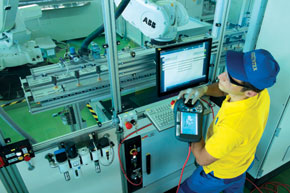 Production control at the Azguntex factory, which produces solar panels and LED lighting. Photo: ABEMDA What has been learnt from the experimental site at Qobustan (the town used to be known as Maraza)?
Production control at the Azguntex factory, which produces solar panels and LED lighting. Photo: ABEMDA What has been learnt from the experimental site at Qobustan (the town used to be known as Maraza)?
In the first place, the experimental site helps to provide power to the town of Qobustan through its hybrid power station. Almost the entire energy supply of the town comes from renewable energy. A surplus of power is generated and the excess goes into the grid. Solar, wind and biomass energy complement each other at the site. If there is a lack of one source of energy, another source may be used. Nature does not follow the power generation schedule. The site’s dispatch centre works with the dispatch centre of power grid operators Azerenerji and they share all data. In future we will be able to coordinate working procedures and give directions and instructions to other producers in order to reduce and solve problems in the general power system. This is the goal.
What other projects are under way to develop alternative and renewable sources of energy?
Large international projects on alternative energy are under way today. A tender was held through German development bank KfW and a feasibility study is being made by a private consulting company for the construction of an 80 MW wind power plant. The location, technology, economic efficiency and financial structure of the plant are all issues that should be considered in the feasibility study.
Another project is being carried out by the Asian Development Bank. A tender is currently under way to select a new company to produce heat and electric power from bio-energy, mainly using residual agricultural waste, and thereby provide the regions and district centres with electric power.
There is a project implemented together with and funded by the United Nations and the European Commission. The main purpose of this project is the construction of a small hydroelectric power plant. The blueprint has been completed. A tender will be held in the near future to select the company that will construct the plant and purchase equipment. This small hydro power plant will be built on the River Kish north of Sheki. One hydroelectric power plant is already operating on the river and the second plant will function in parallel.
What will Azerbaijan gain from alternative energy?
Azerbaijan as a state gets a few simple sources of real profit in this field. Of course, it supports financial and social development as well as the development of intellectual resources. One of the most important factors is that the generation of heat and power from renewable energy sources will mean the conservation of traditional energy sources in Azerbaijan. It will encourage the efficient use of oil and gas resources. This will, therefore, increase Azerbaijan’s hydrocarbon export potential. If we compare export and domestic prices, we can see the opportunity for the country to profit from exports. This could have a major impact on Azerbaijan’s economic indicators.
Today, of course, renewable energy sources do not account for a significant proportion of power generation in Azerbaijan, but as this proportion increases, a new source of profit will arise. At the same time new technologies are brought to the country, new jobs are created, new knowledge is gained and relationships developed. By increasing the level of power generation to the desired point, we will promote the development of other sectors of the economy. The development of renewable energy resources will provide the basis for large dividends and other non-financial benefits for the country.
What will be the impact on fuel prices?
Fuel prices have an impact on the prices for all kinds of energy, including electricity. Under the current tariff policy, considerable subsidies and investments are made in the state energy system. Of course, when prices rise, the amount of subsidy will be reduced. We hope that price policy and the price dynamic will continue to develop in such a way that the generation of renewable energy will help to stabilize these prices. An increase in the price of these energy resources is not expected, since their prices are falling from year to year. On the other hand, the renewable energy system with falling prices will balance the conventional energy resources, the prices for which tend to rise, and will not allow the prices to go up.
How much will be invested in alternative and renewable energy projects?
Both private and state budget funds are being used on these sources. And of course, this amount is expected to increase year on year. Every year on average around 20-30 million manats (19-29 million euros) of funding is provided from the state budget alone. Approximately the same amount of investment is made by private structures.
Who will invest? The state or private companies?
Investments in Azerbaijan today are made mostly through the state and international organizations, because a draft law is currently under discussion. Some technical, legal and regulatory documents have not been developed yet. This situation makes it difficult for private structures to invest and does not ensure efficiency. We hope that after the adoption of new laws in the field of renewable energy, such procedures as the making and return of investments, subsidies and ensuring profitability will be underpinned by the legislation.
How many years will it take for the agency or investors to recoup the cost of projects?
The current tariff policy shows that the return of investments can take four to 20 years, depending on the type of project. After legislation has been developed and a new tariff system created, this period, of course, will be shortened and the term for the return of investments will be limited to a maximum of 12 years.
The State Agency has drawn up a draft strategy for alternative and renewable energy resources until 2020. Can you tell us the main points of the strategy?
The Azerbaijan 2020: Vision of the Future development concept includes provisions on the alternative and renewable energy sector. On 29 December 2011 the head of state signed a resolution on the preparation of a State Strategy on the Use of Alternative and Renewable Energy in the Republic of Azerbaijan for the period 2012 to 2020. This strategy has already been prepared and submitted to the Cabinet of Ministers, and almost all the conclusions and proposals have been accepted. We are going to present the latest version of this strategy to the Presidential Administration in the near future.
Wind, solar, hydroelectric and biomass power have been set as the priority areas and their structural division defined. Azerbaijan’s diverse climate, with continental, mild and subtropical zones, and its varied terrain of mountains, plateaus, plains and lowlands are highly favourable for these types of power generation.
Achieving goals set by the European Union for 2020 is very important for Azerbaijan and is considered one of the main aims of the strategy. We have set a target of the generation of 20 per cent of electricity from renewable sources by 2020. The strategy includes the measures to be taken in legislation, structural and institutional development and where funds will come from to achieve these objectives. The strategy reflects the current policy and views of the state. We hope that this strategy will lead to the formation of specific projects, plans, relevant legislation and other technological and creative documents. These are the key points of our strategy.
Power generation from renewable sources is often more expensive than conventional power generation. What incentives does the strategy envisage to tackle this problem? Will there be an increase in energy tariffs or subsidies for generators?
Both tariffs and subsidies are specified in improvements to the legislative and regulatory framework for power generation from alternative and renewable energy. At the same time, the following stimuli are also planned:
• Exemption from customs duties and VAT for all equipment and spare parts used in all areas of alternative and renewable power generation imported into the country, up to and including 2020
• Tax exemptions in the field of alternative and renewable power generation up to and including 2020
• Loans and investments from the state budget in order to ensure development
• On the basis of international experience, guaranteed subsidies and grants for capital investment alongside tax and customs breaks for local enterprises producing the equipment and machinery used for alternative and renewable energy. This includes a special tariff policy for projects which use locally produced equipment.
Official statistics show that a small amount of wind power was generated in 2009 and 2010, but then stopped. Can you tell us why?
It is very simple. A private entity, the Caspian Technology Company, was producing wind energy as a pilot project. Approximately 3 million kWh of energy per year were produced by two turbines, each with a capacity of 750 kW. They were planning to construct more power plants in the future, but were not satisfied with the existing tariff and financial systems and encountered some difficulties. It was obvious that this equipment needed to be maintained on a regular basis and that funds had to be used exclusively for the operation of the equipment. The future development of the company was in doubt and it closed down. However, another private structure built a more than 8 MW power plant and we hope that this year statistics for wind power will be higher than in 2009 and 2010.
What is this private structure? Can you explain?
It’s a private body. To be honest, I don’t want to mention their names, but you will see for yourself in the statistics.
A consortium working on the pilot wind project, Nordwind Energien/Temirmashin, told the press in early 2010 that they faced three main problems with wind power in Azerbaijan: the wind was too strong or too weak; electricity tariffs were very low; and they were not able to import wind turbine blades for a reasonable price. We have already talked about tariffs. How serious are the problems connected with the “right kind of wind” and the import of turbine blades?
By decision No 161 of the Cabinet of Ministers in December 2003, wind power equipment was exempted from import duty and by decision No 220 of December 2007, imported wind power equipment was exempted from VAT. International experience shows that energy can be produced using existing technology with wind speeds of 3-25 mps (metres per second). If more expensive, advanced technology is used, energy can be generated from wind speeds of 1-60 mps. Wind energy potential in Azerbaijan is calculated at 10,000 MW. Steps will be taken to increase wind power production to 5.6% of all power generated by 2020, including 4% offshore and 1.6% onshore. Wind will then account for 28% of all power generated from alternative and renewable energy.
Does the State Agency for Alternative and Renewable Energy run any power stations or other facilities?
This is done by the Azalternativenerji limited liability company which is subordinate to the State Agency. The Qobustan Experimental Site is run by Azalternativenerji. The site, which covers 38 hectares, has wind, solar and biogas stations.
Another facility is the Azguntex factory near Sumqayit, which has two production lines – one producing solar panels and the other LED lighting.
In addition to the above, there are small power stations in various regions of Azerbaijan.
 Production control at the Azguntex factory, which produces solar panels and LED lighting. Photo: ABEMDA
Production control at the Azguntex factory, which produces solar panels and LED lighting. Photo: ABEMDA In the first place, the experimental site helps to provide power to the town of Qobustan through its hybrid power station. Almost the entire energy supply of the town comes from renewable energy. A surplus of power is generated and the excess goes into the grid. Solar, wind and biomass energy complement each other at the site. If there is a lack of one source of energy, another source may be used. Nature does not follow the power generation schedule. The site’s dispatch centre works with the dispatch centre of power grid operators Azerenerji and they share all data. In future we will be able to coordinate working procedures and give directions and instructions to other producers in order to reduce and solve problems in the general power system. This is the goal.
What other projects are under way to develop alternative and renewable sources of energy?
Large international projects on alternative energy are under way today. A tender was held through German development bank KfW and a feasibility study is being made by a private consulting company for the construction of an 80 MW wind power plant. The location, technology, economic efficiency and financial structure of the plant are all issues that should be considered in the feasibility study.
Another project is being carried out by the Asian Development Bank. A tender is currently under way to select a new company to produce heat and electric power from bio-energy, mainly using residual agricultural waste, and thereby provide the regions and district centres with electric power.
There is a project implemented together with and funded by the United Nations and the European Commission. The main purpose of this project is the construction of a small hydroelectric power plant. The blueprint has been completed. A tender will be held in the near future to select the company that will construct the plant and purchase equipment. This small hydro power plant will be built on the River Kish north of Sheki. One hydroelectric power plant is already operating on the river and the second plant will function in parallel.
What will Azerbaijan gain from alternative energy?
Azerbaijan as a state gets a few simple sources of real profit in this field. Of course, it supports financial and social development as well as the development of intellectual resources. One of the most important factors is that the generation of heat and power from renewable energy sources will mean the conservation of traditional energy sources in Azerbaijan. It will encourage the efficient use of oil and gas resources. This will, therefore, increase Azerbaijan’s hydrocarbon export potential. If we compare export and domestic prices, we can see the opportunity for the country to profit from exports. This could have a major impact on Azerbaijan’s economic indicators.
Today, of course, renewable energy sources do not account for a significant proportion of power generation in Azerbaijan, but as this proportion increases, a new source of profit will arise. At the same time new technologies are brought to the country, new jobs are created, new knowledge is gained and relationships developed. By increasing the level of power generation to the desired point, we will promote the development of other sectors of the economy. The development of renewable energy resources will provide the basis for large dividends and other non-financial benefits for the country.
What will be the impact on fuel prices?
Fuel prices have an impact on the prices for all kinds of energy, including electricity. Under the current tariff policy, considerable subsidies and investments are made in the state energy system. Of course, when prices rise, the amount of subsidy will be reduced. We hope that price policy and the price dynamic will continue to develop in such a way that the generation of renewable energy will help to stabilize these prices. An increase in the price of these energy resources is not expected, since their prices are falling from year to year. On the other hand, the renewable energy system with falling prices will balance the conventional energy resources, the prices for which tend to rise, and will not allow the prices to go up.
How much will be invested in alternative and renewable energy projects?
Both private and state budget funds are being used on these sources. And of course, this amount is expected to increase year on year. Every year on average around 20-30 million manats (19-29 million euros) of funding is provided from the state budget alone. Approximately the same amount of investment is made by private structures.
Who will invest? The state or private companies?
Investments in Azerbaijan today are made mostly through the state and international organizations, because a draft law is currently under discussion. Some technical, legal and regulatory documents have not been developed yet. This situation makes it difficult for private structures to invest and does not ensure efficiency. We hope that after the adoption of new laws in the field of renewable energy, such procedures as the making and return of investments, subsidies and ensuring profitability will be underpinned by the legislation.
How many years will it take for the agency or investors to recoup the cost of projects?
The current tariff policy shows that the return of investments can take four to 20 years, depending on the type of project. After legislation has been developed and a new tariff system created, this period, of course, will be shortened and the term for the return of investments will be limited to a maximum of 12 years.
